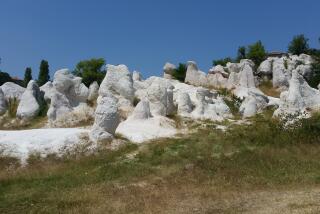Female ‘Indiana Jones’ Relishes the Chase
- Share via
GUANAJA, Honduras — She grins hideously, baring fangs as long as railroad spikes--60 teeth made for pulverizing tons of muscle, guts and bone.
She is the largest and most complete skeleton of a Tyrannosaurus rex ever found.
And her name is Sue.
It’s a dainty name for the lizard king, after 67 million years still the most fearsome predator to tread Earth. Cleaned, CT-scanned and reconnected, she will be unveiled Wednesday at the Field Museum of Natural History in Chicago. Already the museum is hawking T-shirts and refrigerator magnets bearing her menacing profile and that name.
Sue.
Why Sue?
Because she is named after Sue Hendrickson, the woman who found her and helped pry her bones from the Badlands of South Dakota.
Hendrickson is no university professor, no museum curator. She isn’t even a scientist.
She is a high school dropout, a self-taught maverick, a real-life Indiana Jones who has unearthed scientific and archeological treasures all over the world. The greatest T. rex skeleton of all might not even be her greatest find. In fact, dinosaurs rank low on her list of scientific passions.
In the Dominican Republic, she found a trio of exquisite butterflies, extinct for 24 million years, trapped for eternity in jewel-like amber.
In the Peruvian desert, she unearthed a graveyard of whales stranded hundreds of miles from the ocean for 12 million years.
In Egypt, she raised treasures from Cleopatra’s palace and Napoleon’s warships, both submerged in Alexandria’s murky harbor.
Off the Philippines, she recovered a trove of Ming Dynasty Chinese porcelain from a sunken Spanish galleon.
Now 50 years old and weathered by a lifetime of adventure, Hendrickson might be the most accomplished explorer you’ve never heard of. And she wishes it would stay that way.
“Never find anything good,” she warns. “Everyone will want it.”
At the crest of acclaim in her field, she has retreated to her sprawling house on Guanaja, a tiny roadless island 40 miles off the coast of Honduras. In 1502 Christopher Columbus, an explorer with a deeper appreciation for celebrity, landed on a palm-fringed beach a few miles from her dock.
This is her first permanent address in the 33 years since she ran away from her Munster, Ind., home at the age of 17. On a bluff overlooking the Caribbean, where the sunset blossoms like an orchid, Hendrickson is trying to reclaim what she has lost in 10 years of jubilation and disillusionment since she found the T. rex.
Tops on her list: Solitude.
“I’m a frustrated hermit,” she says, hurling a tennis ball off the veranda so her eight dogs will give chase.
Robert Bakker, curator of the Tate Geological Museum in Casper, Wyo., and author of the bestseller “The Dinosaur Heresies,” says Hendrickson is a lot more than that. He describes her as a woman driven to find provocative specimens that smash our illusions and replace them with new truths.
“She can find nearly anything,” Bakker says. “To find something that adds a brick to the edifice of knowledge is eternal. It’s a way of becoming immortal.”
And remarkably, he points out, she is self-taught.
Hendrickson rolls her blue eyes in disbelief that anyone would care about her academic credentials. Or lack thereof.
“People make such a big deal about the dropout thing,” she says. “I’ve got a good, logical mind, and I teach myself.”
How does a dropout become a major figure in the corridors of science?
By perseverance.
Growing up outside Chicago, she was an A student until rebellion struck, and she ran away with a boyfriend to live on the water.
They sewed sails in Seattle, then skipped to a marina near San Francisco. “I didn’t wear shoes for two years,” she recalls wistfully. When they broke up, she moved to the Florida Keys to dive for lobsters and then for salvage--sunken yachts, crashed airplanes, lost cargo.
For years she lived like a mermaid, rarely wearing more than a bikini, netting tropical fish for collectors. What fish she didn’t recognize she would drive 90 miles to an oceanography lab in Miami. Many turned out to be new species.
Hendrickson toyed with becoming a marine biologist. Just in case, her mother, now 86, kept saving for tuition until Hendrickson’s 30th birthday.
But why study for years to do what she was already good at? Why spend nights hunched over a microscope when you could sleep under the stars?
So she cast her net farther.
In the Dominican Republic, she hiked into the mountains, where miners showed her chunks of amber. The petrified tree sap was crammed with ancient insects in suspended animation. It was like holding another planet in her palm.
A career was born. Soon she was selling fish, amber, fossils, artifacts and salvage--whatever she could find. Before each expedition, she would visit scholars and review research to learn what to look for.
For years, she has offered important specimens to the Smithsonian Institution and other top museums at bargain rates, or sometimes donated them. She peddles the rest.
A dazzling ammonite from Morocco might bring hundreds. A fossil turtle might go for $35,000. Rare dinosaurs fetch even more.
For this, Hendrickson courts the scorn of some academics.
Paleontologists are outraged by fossil speculating. Thieves, they say, can ruin years of careful excavation in overnight raids. Many specimens are poached from public lands. The lure of profits turns scientific specimens into coveted trophies.
“It’s extremely lucrative,” said Vincent Santucci, paleontologist for the National Park Service. “Poachers are out there in greater numbers now. They will take fossils regardless of the risk.”
Hendrickson condemns the bandits. However, she points out, paleontology has relied on amateurs for nearly two centuries. The first fossil to be identified as a dinosaur was an iguanodon tooth found by an English physician’s wife in 1822.
After the Civil War, rival paleontologists Edward Drinker Cope and Othniel Charles Marsh conducted a dinosaur version of the Gold Rush across the American West, employing amateurs who used picks, shovels and even dynamite. Today the 136 species they unearthed remain mainstays of museum displays.
The relationship between scientists and amateurs soured only recently as prices soared and research funding dwindled.
“The academics are snobs,” Hendrickson declares. “I spend all my time in the field. They might dig something every few years when they get funding. They resent it when somebody finds another way to do it.
“Believe me, nobody gets rich selling fossils,” she says. “But museums always have bought fossils. Always.”
But only the Field Museum has paid $8.3 million for a single skeleton.
For Sue.
The specimen’s unveiling will be the epilogue to paleontology’s best melodrama since Cope and Marsh.
It began in the summer of 1990. Hendrickson was living like a prairie dog in a dusty campsite near Faith, S.D. No shower. No toilet. Midday temperatures topped 110 degrees. There, she and then boyfriend Peter Larson, president of a private group that collects fossils, were excavating a triceratops.
It was a substantial find that might interest several museums. But the creature’s huge bony frill was crushed. On their knees under the blazing sun, they collected bone chips in plastic bags.
To relieve the scorching monotony, they would survey distant outcrops on adjacent ranches. One exposure, rock laid down during the Cretaceous Period, tugged at Hendrickson. “I felt drawn to that formation for two weeks.” she says. “I can’t explain it.”
Larson can. “She was created to find things,” he says. “She has an excellent eye for subtle differences in color and texture. She has an innate ability to know that something is important. And she doesn’t give up.”
One August morning, Hendrickson and her golden retriever, Gypsy, made their way to the formation and began exploring. A trio of plate-sized vertebrae poked from a sandstone ledge. Fragments that trickled down around her boots had a honeycombed texture, like a bird’s bones.
Hendrickson did the arithmetic of paleontology. Cretaceous plus honeycombed equals large meat eater. Excavations revealed it was the biggest and best T. rex ever found. It was Sue, the Hope Diamond of fossils.
But like the Hope Diamond, Sue carries a curse.
Larson paid rancher Maurice Williams $5,000 to excavate Sue from what he claimed to be his land. But Williams cried foul when he learned the fossil could be worth far more.
So did the Sioux Indian tribe and the federal government. Both claimed ownership because the bluff is on the Cheyenne River Indian Reservation.
Federal agents seized the bones as if they were crates of cocaine. They carted away Larson’s files on past digs too, and began prying into his past, eventually spending $7 million on the investigation.
In the end, the government found no crime in Sue’s discovery and excavation. But they did prosecute Larson for currency violations involving overseas fossil sales, and he was sentenced to two years in prison.
The case polarized paleontology. Years later, hard feelings persist.
Santucci and other scientists employed on public lands say Larson’s prosecution was a stern rebuke to freelancers and reinforced the necessity of obtaining clear permission to collect bones.
Bakker condemns the case as a “scientific jihad” against amateurs. “Nature is the greatest vandal,” he says. “There are specimens literally rotting in the ground as we speak. We need the amateurs to collect them.”
As for Sue, a court declared the rancher, Williams, to be her rightful owner. The fossil was put up for auction in 1997 at the same posh Manhattan auction house that set record prices for Van Gogh paintings and Jackie O’s baubles. After a 10-minute bidding frenzy, the Field Museum bought it for $8.3 million.
The shock of the trial and the auction publicity drove Hendrickson overseas, and back underwater.
Off the Philippines, she helped French archeologist Franck Goddio find the San Diego, a Spanish galleon sunk in 1600. Hendrickson calls it the “Sue of shipwrecks.” They found the skeletal remains of 100 crewmen and 28,000 artifacts.
“Every day we came up with something amazing,” she says.
More recently, Hendrickson and Goddio have been surveying Cuba’s coastline with sonar for more wrecks--the first study of its kind permitted by the secretive Castro regime.
Hendrickson has paid for her wanderlust. She was married once, but now is single. Her features are wrinkled, bleached and freckled by the sun. Her left leg swells grotesquely from a lymph infection contracted in Alexandria’s filthy waters. She also has had surgery for cervical cancer.
These days she is trying to live like the rest of us--under a roof. Of course, her address is Guanaja, not Munster. Her hobbies include bottle-feeding a rescued baby deer and racing a speedboat at night over coral reefs.
When Hurricane Mitch interrupted her newfound domesticity in 1998, blowing two nearby villages out to sea, she pitched in to help her neighbors. “In the first two weeks after the hurricane I watched Susan pass out $20,000 of her own money,” said Bill Smith, a pastor from Bozeman, Mont., who is raising money for the rebuilding.
Hendrickson can’t sit still anyplace for long. When she starts complaining of “itchy feet,” it means it’s time to go exploring.
“I just want to feel that discovery moment again,” she says.
So will it be shipwrecks or dinosaurs? Amber or ammonites?
Gazing over the shimmering Caribbean, Hendrickson’s blue eyes bulge at news that scientists in Siberia have thawed the woolly carcass of an Ice Age mammoth.
“I’ve always wanted to find a mammoth,” she says softly.
It won’t be long before she finds something, somewhere. The only question is whether she’ll take her own advice:
This time, don’t find anything good.
On the Net:
https://www.fmnh.org
https://www.bhigr.com
More to Read
The biggest entertainment stories
Get our big stories about Hollywood, film, television, music, arts, culture and more right in your inbox as soon as they publish.
You may occasionally receive promotional content from the Los Angeles Times.










